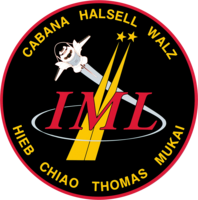STS-65
 | |
| Dane misji | |
| Indeks COSPAR | 1994-039A |
|---|---|
| Zaangażowani | |
| Oznaczenie kodowe | STS-65 |
| Pojazd | |
| Wahadłowiec | Columbia |
| Załoga | |
 | |
| Dowódca | Robert Cabana |
| Start | |
| Miejsce startu | Stany Zjednoczone, KSC, LC39-A |
| Początek misji | 8 lipca 1994 16:43:00 UTC |
| Orbita okołoziemska | |
| Apogeum | 304 km |
| Perygeum | 300 km |
| Okres orbitalny | 90,5 min |
| Inklinacja orbity | 28,4° |
| Lądowanie | |
| Miejsce lądowania | KSC, Pas startowy 33 |
| Lądowanie | 23 lipca 1994 10:37:59,448 UTC |
| Czas trwania misji | 14 dni, 17 godz, 55 min |
| Przebyta odległość | 9 816 998 km[1] |
| Liczba okrążeń Ziemi | 235[1] |
| Program lotów wahadłowców | |
STS-65 (ang. Space Transportation System) – siedemnasta misja wahadłowca kosmicznego Columbia i sześćdziesiąta trzecia programu lotów wahadłowców[2].
Załoga
- źródło[2]
- Robert Cabana (3)*, dowódca (CDR)
- James Halsell (1), pilot (PLT)
- Richard Hieb (3), dowódca ładunku (MS1)
- Carl Walz (2), specjalista misji 2 (MS2)
- Leroy Chiao (1), specjalista misji 3 (MS3)
- Donald A. Thomas (1), specjalista misji 4 (MS4)
- Chiaki Naito-Mukai (1), specjalista ładunku 1 (PS) (Japonia)
Załoga rezerwowa
Jean-Jacques Favier (0), rezerwowy specjalista ładunku (CNES)
- *(liczba w nawiasie oznacza liczbę lotów odbytych przez każdego z astronautów)
Parametry misji
- Masa:
- Perygeum: 300 km[3]
- Apogeum: 304 km[3]
- Inklinacja: 28,4°[3]
- Okres orbitalny: 90,5 min[3]
Cel misji
Drugi lot laboratorium naukowego IML-2 (International Microgravity Laboratory)[2].
Zobacz też
Przypisy
- ↑ a b c d e Mark Wade: STS-65 (ang.). W: Encyclopedia Astronautica [on-line]. [dostęp 2017-07-25].
- ↑ a b c Tomáš Přibyl: Dzień, w którym nie wróciła COLUMBIA. Bielsko-Biała: Wydawnictwo >DEBIT<, 2003, s. 169. ISBN 83-7167-224-1.
- ↑ a b c d STS 65 (ang.). W: NSSDCA Master Catalog [on-line]. NASA. [dostęp 2014-06-11]. [zarchiwizowane z tego adresu (2016-03-08)].
Linki zewnętrzne
- podsumowanie misji STS-65 na stronie KSC (ang.)
- Mark Wade: STS-65 (ang.). W: Encyclopedia Astronautica [on-line]. [dostęp 2017-07-25].
- Spaceflight mission report: STS-65 (ang.). Spacefacts. [dostęp 2017-07-25].
Media użyte na tej stronie
The flag of Navassa Island is simply the United States flag. It does not have a "local" flag or "unofficial" flag; it is an uninhabited island. The version with a profile view was based on Flags of the World and as a fictional design has no status warranting a place on any Wiki. It was made up by a random person with no connection to the island, it has never flown on the island, and it has never received any sort of recognition or validation by any authority. The person quoted on that page has no authority to bestow a flag, "unofficial" or otherwise, on the island.
The crew assigned to the STS-65 mission included (seated left to right) Richard J. (Rick) Hieb, payload commander; Robert D. (Bob) Cabana, commander; and Donald A. Thomas, mission specialist. Standing, from left to right, are Leroy Chiao, mission specialist; James D. Halsell, pilot; Chiaki Naito-Mukai, payload specialist; and Carl E. Walz, mission specialist. Launched aboard the Space Shuttle Columbia on July 8, 1994 at 12:43:00 pm (EDT), the STS-64 mission marked the second flight of the International Microgravity Laboratory (IML-2) and the first flight of a female Japanese crew member.
STS-65 Mission Insignia


